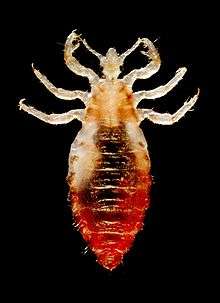Body louse
The body louse (Pediculus humanus humanus, sometimes called Pediculus humanus corporis)[1] is a hematophagic louse that infests humans. The condition of being infested with head lice, body lice, or pubic lice is known as pediculosis.[2] Body lice are vectors for the transmission of the human diseases epidemic typhus, trench fever, and relapsing fever.[3] The body louse genome sequence analysis was published in 2010.[4][5]
| Body louse | |
|---|---|
 | |
| Scientific classification | |
| Kingdom: | Animalia |
| Phylum: | Arthropoda |
| Class: | Insecta |
| Order: | Phthiraptera |
| Family: | Pediculidae |
| Genus: | Pediculus |
| Species: | P. humanus |
| Subspecies: | P. h. humanus |
| Trinomial name | |
| Pediculus humanus humanus Linnaeus, 1758 | |
Life cycle and morphology
Pediculus humanus humanus (the body louse) is indistinguishable in appearance from Pediculus humanus capitis (the head louse) but will interbreed only under laboratory conditions. In their natural state, they occupy different habitats and do not usually meet. In particular, body lice have evolved to attach their eggs to clothes, whereas head lice attach their eggs to the base of hairs.
The life cycle of the body louse consists of three stages: egg (also called a nit), nymph, and adult.[6]
- Nits are louse eggs. They are generally easy to see in the seams of an infested person's clothing, particularly around the waistline, under armpits or even in body hair. They are oval and usually yellow to white in color. Body lice nits may take 1–2 weeks to hatch.[6]
- A nymph is an immature louse that hatches from the nit (egg). A nymph looks like an adult body louse, but is smaller. Nymphs mature into adults about 9–12 days after hatching. To live, it must feed on blood.[6]
- The adult body louse is about the size of a sesame seed (2.5–3.5 mm), has six legs, and is tan to greyish-white. Females lay eggs. To live, lice must feed on blood. If separated from their hosts, lice die.[6]
Origins
The body louse diverged from the head louse at around 100,000 years ago, hinting at the time of the origin of clothing.[7][8][9] Body lice were first described by Carl Linnaeus in the 10th edition of Systema Naturae. The human body louse had its genome sequenced in 2010, and at that time it had the smallest known insect genome.[5] Other lice that infest humans are the head louse and the crab louse. The claws of these three species are adapted to attachment to specific hair diameters.[2]
See also
References
- Buxton, Patrick A. (1947). "The Anatomy of Pediculus humanus". The Louse; an account of the lice which infest man, their medical importance and control (2nd ed.). London: Edward Arnold. pp. 5–23.
- Hoffman, Barbara (2012). Williams gynecology. New York: McGraw-Hill Medical. p. 90. ISBN 9780071716727.
- Bonilla, DL; Durden, LA; Eremeeva, ME; Dasch, GA; Heitman, J (2013). "The Biology and Taxonomy of Head and Body Lice—Implications for Louse-Borne Disease Prevention". PLoS Pathogens. 9 (11): e1003724. doi:10.1371/journal.ppat.1003724. PMC 3828170. PMID 24244157.
- Pittendrigh BR; et al. (2006). "Proposed sequencing of a new target genome: the human body louse, Pediculus humanus humanus". J. Med. Entomol. 43 (6): 1103–1111.
- Kirkness EF, Haas BJ, et al. (2010). "Genome sequences of the human body louse and its primary endosymbiont provide insights into the permanent parasitic lifestyle". Proceedings of the National Academy of Sciences. 107 (27): 12168–12173. doi:10.1073/pnas.1003379107. ISSN 0027-8424. PMC 2901460. PMID 20566863.
- "Body lice: Biology". Centers for Disease Control and Prevention. Retrieved 15 July 2016.
- Ralf Kittler; Manfred Kayser; Mark Stoneking (2003). "Molecular evolution of Pediculus humanus and the origin of clothing" (PDF). Current Biology. 13 (16): 1414–1417. doi:10.1016/S0960-9822(03)00507-4. PMID 12932325. Archived from the original on 2007-07-10. Retrieved 2008-09-01.CS1 maint: BOT: original-url status unknown (link)
- Stoneking, Mark. "Erratum: Molecular evolution of Pediculus humanus and the origin of clothing". Retrieved March 24, 2008.Archive
- Toups, MA; Kitchen, A; Light, JE; Reed, DL (2010). "Origin of Clothing Lice Indicates Early Clothing Use by Anatomically Modern Humans in Africa". Molecular Biology and Evolution. 28 (1): 29–32. doi:10.1093/molbev/msq234. PMC 3002236. PMID 20823373.
External links
- Body and head lice on the UF / IFAS Featured Creatures Web site